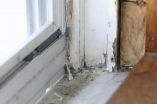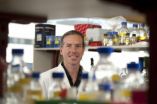(Press-News.org) WASHINGTON, D.C. (March 6, 2011) -- From grinding heavy metal to soothing ocean waves, the sounds we hear are all perceptible thanks to the vibrations felt by tiny molecular motors in the hair cells of the inner ear. Researchers at the University of Pennsylvania School of Medicine have now identified the mechanism by which a single amino acid change can disrupt the normal functioning of one of the critical components of that physiology -- a molecular motor protein called myo1c, which resides in the cochlea of the inner ear.
The mutation (called R156W), was first identified in an individual suffering from cochlear hearing loss, and it affects the way the myo1c protein interacts with proteins known as actin filaments, another crucial component of the sensory apparatus of the inner ear. This interaction is essential for normal hearing, and scientists have already traced other causes of hearing loss to previously known mutations that interrupt it.
Now Michael Greenberg and his colleagues at UPenn have examined the biochemical and mechanical properties of the mutant myosin protein. Comparing constructs of the normal, "wild-type" protein to the R156W mutant, they examined the two proteins' kinetics and motility and discovered the mutant has a reduced sensitivity to mechanical loads and a lower duty ratio, meaning it spends less time attached to actin filaments.
Though the cochlear cell myo1c defects are associated with hearing loss, how this mutation causes the disease is still a mystery. The exact molecular role of myo1c is hazy, although it has been linked to several important cellular processes including hearing and insulin stimulated glucose uptake within cells. Understanding the defects caused by the R156 mutation could help to solve the puzzle.
"R156 is a highly conserved residue throughout the myosin superfamily. The fact that mutation of this residue affects the myosin duty ratio and strain sensitivity may very well be applicable in other myosins as well. In the long term, we hope to gain greater insight into the mechanism of myosin strain sensitivity and its role in mechanotransduction," says Greenberg.
###
The group's research is funded by the National Institutes of Health and the American Heart Association.
The Presentation, "A HEARING-LOSS ASSOCIATED MYO1C MUTATION (R156W) DECREASES THE MYOSIN DUTY RATIO AND FORCE SENSITIVITY" is at 1:45 p.m. on Sunday, March 6, 2011 in Hall C of the Baltimore Convention Center.
ABSTRACT: http://tinyurl.com/4llnmve
MORE MEETING INFORMATION
Each year, the Biophysical Society Annual Meeting brings together more than 6,000 scientists and hosts more than 4,000 poster presentations, 200 exhibits, and more than 20 symposia. The largest meeting of its type in the world, the Biophysical Society Annual Meeting retains its small-meeting flavor through its subgroup meetings, platform sessions, social activities, and committee programs.
QUICK LINKS
Meeting Home Page:
http://www.biophysics.org/2011meeting
General Meeting Information:
http://www.biophysics.org/GeneralInfo/Overview/tabid/2062/Default.aspx
Search abstracts:
http://www.abstractsonline.com/plan/start.aspx?mkey={FEA830A5-24AD-47F3-8E61-FCA29F5FEF34}
PRESS REGISTRATION
The Biophysical Society invites credentialed journalists, freelance reporters working on assignment, and public information officers to attend its Annual Meeting for free. For more information on registering as a member of the press, please contact Ellen Weiss at eweiss@biophysics.org or 240-290-5606. Also see: http://www.biophysics.org/Registration/Press/tabid/2148/Default.aspx
ABOUT THE BIOPHYSICAL SOCIETY
The Biophysical Society, founded in 1956, is a professional, scientific society established to encourage development and dissemination of knowledge in biophysics. The society promotes growth in this expanding field through its annual meeting, monthly journal, and committee and outreach activities. Its over 9,000 members are located throughout the U.S. and the world, where they teach and conduct research in colleges, universities, laboratories, government agencies, and industry. For more information on the society or the 2011 Annual Meeting, visit www.biophysics.org
END
Home energy retrofits tackle climate change and when done right they should make homes healthier, while aiding families struggling with utility bills.
Without adequate training and precaution, however, renovators, energy retrofitters and do-it-yourselfers who disturb lead-based paint, asbestos insulation and other toxic materials in older buildings put the health of all -- especially children -- living there at risk of serious health impacts.
Lead exposure can potentially lead to lowered intelligence and worse; asbestos exposure can potentially lead to debilitating ...
PROVIDENCE, R.I. [Brown University] — For years brain scientists have puzzled over the shadowy role played by the molecule putrescine, which always seems to be present in the brain following an epileptic seizure, but without a clear indication whether it was there to exacerbate brain damage that follows a seizure or protect the brain from it. A new Brown University study unmasks the molecule as squarely on the side of good: It seems to protect against seizures hours later.
Putrescine is one in a family of molecules called "polyamines" that are present throughout the body ...
Starting rehabilitation sooner following knee arthroplasty surgery could pay dividends - for both patients and hospitals. Commencing physical therapy within 24 hours of surgery can improve pain, range of joint motion and muscle strength as well as cut hospital stays, according to new research in the journal Clinical Rehabilitation, published by SAGE.
Mindful of the trend towards discharging patients from hospital more rapidly after surgery in recent years, physical therapy and public health researchers from Almeria, Malaga and Granada in Spain set out to investigate whether ...
The largest-ever study of its type into coronary heart disease, involving scientists from the University of Leicester, has uncovered 13 new genes that increase risk of heart attacks.
Professor Nilesh Samani, British Heart Foundation Professor of Cardiology at the University of Leicester, based at Glenfield Hospital, who co-led the international research programme, called CARDIoGRAM, said most of genes identified were not previously known to be involved in the development of coronary heart disease, opening of the possibility of developing new treatments for this common ...
STANFORD, Calif. — Thirteen new gene regions have been convincingly linked to coronary atherosclerosis in a massive, new, international genetics study involving investigators from the Stanford University School of Medicine.
The results of the study, to be published online March 6 in Nature Genetics, provide 13 vital new clues on the etiology of this disease, the most common cause of death worldwide. The study doubles the number of gene regions previously known to predispose people to this condition. Coronary atherosclerosis is the process by which plaque builds up in ...
Scientists have identified a single mutated gene that causes Hajdu-Cheney syndrome, a disorder of the bones causing progressive bone loss and osteoporosis (fragile bones). The study, published in Nature Genetics today, gives vital insight into possible causes of osteoporosis and highlights the gene as a potential target for treating the condition.
There are only 50 reported cases of Hajdu-Cheney syndrome (HCS), of which severe osteoporosis is a main feature. Osteoporosis is a condition leading to reduction in bone strength and susceptibility to fractures. It is the most ...
Clinical research has greater societal impact over a 15-20 year timescale, while basic research has greater academic impact, according to a new study from RAND Europe and the Health Economics Research Group (HERG) at Brunel University.
Project Retrosight was a multinational, four-year study that investigated the translation of basic biomedical and clinical cardiovascular and stroke research, and its impact on future work, policy, products and healthcare. The study was based on a rich source of material taken from 29 carefully selected case studies of grants for research ...
OTTAWA – March 6, 2011 – Insight into the complex biological mechanisms that cause heart disease has taken a major step forward with the discovery of 13 new genes that increase the risk of coronary artery disease (CAD). The influence of the majority of the new genes is independent of other established risk factors, suggesting new, unsuspected causes of CAD. The discovery more than doubles the number of genes known to affect the progression of heart disease.
The research also verified the association of 10 previously identified genes to the population at large, meaning ...
Scientists from the Walter and Eliza Hall Institute have identified the key immune cell population responsible for regulating the body's immune response.
The finding could have wide-ranging repercussions for the treatment of autoimmune diseases, organ transplantation and cancer, and change how the efficacy of newly developed drugs is measured.
The discovery was made by Dr Erika Cretney, Dr Axel Kallies and Dr Stephen Nutt from the institute's Molecular Immunology division. It centred on a population of immune cells called regulatory T cells.
Regulatory T cells (T-regs) ...
Japanese researchers have been immersing iron-based compounds in hot alcoholic beverages such as red wine, sake and shochu to induce superconductivity.
Scientists from the National Institute for Materials Science, Japan, found that immersing pellets of an iron-based compound in heated alcoholic beverages for 24 hours greatly increase their superconducting ability.
Iron-based compounds usually become superconductive after being exposed to air. This process however can take up to several months. This study demonstrated that superconductivity can be induced in just one ...

